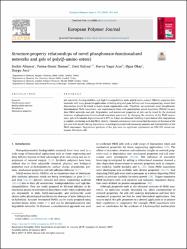Structure-property relationships of novel phosphonate-functionalized networks and gels of poly(beta-amino esters)
Özet
pH sensitivity, biodegradability and high biocompatibility make poly(beta-amino esters) (PBAEs) important biomaterials with many potential applications including drug and gene delivery and tissue engineering, where their degradation should be tuned to match tissue regeneration rates. Therefore, we synthesize novel phosphonate-functionalized PBAE macromers, and copolymerize them with polyethylene glycol diacrylate (PEGDA) to produce PBAE networks and gels. Degradation and mechanical properties of gels can be tuned by the chemical structure of phosphonate-functionalized macromer precursors. By changing the structure of the PBAE macromers, gels with tunable degradations of 5-97% in 2 days are obtained. Swelling of gels before/after degradation is studied, correlating with the PBAE identity. Uniaxial compression tests reveal that the extent of decrease of the gel cross-link density during degradation is much pronounced with increasing amount and hydrophilicity of the PBAE macromers. Degradation products of the gels have no significant cytotoxicity on NIH 3T3 mouse embryonic fibroblast cells.



















